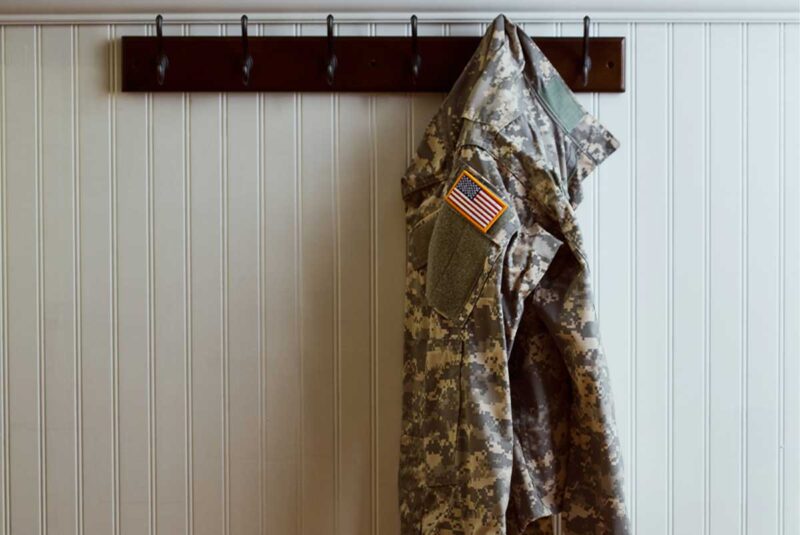Ready To Buy a Home?
Get Approved to Buy a Home
Rocket Mortgage® lets you get to house hunting sooner.
With perks like no required down payment and free mortgage loan counseling, it’s no wonder U.S. Department of Veterans Affairs (VA) loans are a popular option for the military community. The catch is you must meet minimum service requirements to apply for a VA loan.
However, with joint VA loans, non-military borrowers also have an opportunity to participate in the program. Read on to learn how the process works, what differs compared to a traditional VA loan and the next steps to applying.
How Do Joint VA Loans Work?
Explore Your Mortgage Options
What are you looking to do?
A joint VA loan means at least two people have applied for a VA loan together. As long as one of the applicants qualifies for the entitlement, the other borrowers don’t have to meet eligibility requirements. Borrowers will share responsibility for repayment if the loan is approved.
The VA divides these loans into two categories:[1]
- Veteran/nonveteran joint loan: This loan is for any combination of borrowers that includes at least one veteran and one nonveteran.
- Two veteran joint loan: This loan involves at least two veterans applying jointly, with each using their own VA entitlement. Despite the name, it can include loans with three, four, or more veterans – but they all have to use their entitlement.
There’s no legal limit to how many people can be on a mortgage. That said, lenders usually set their own limits, and typically, everyone involved has to qualify for the loan.
Keep in mind that lenders issue the loans, not the VA. You’ll have to meet the lender’s requirements for things like debt-to-income (DTI) ratio and credit score because they’re the ones assuming the risk for the mortgage.
Joint VA loans vs. traditional VA loans
The VA guarantees a portion of all VA loans that are issued. This security allows lenders to provide perks, like no down payment and looser qualification standards compared to those for conventional loans.
However, the VA only makes these guarantees for qualifying service members. When civilians are co-applicants on a joint VA loan, the VA doesn’t make any guarantees for them.
To offset this risk, lenders may ask for a down payment from the non-military co-borrower(s).
Get approved to buy a home.
Rocket Mortgage® lets you get to house hunting sooner.
Who Can Apply for a Joint VA Loan?
When marriage isn’t involved, anyone can be a co-applicant for a joint VA loan – as long as at least one of the applicants meets the minimum service requirements to qualify for a VA loan.
Here are some common examples provided by the VA:[1]
- One veteran using their entitlement and four nonveterans
- Two veterans using their entitlements and two veterans not using their entitlements
- Three veterans using their entitlements and one nonveteran
The technical definitions can change when spouses are involved, depending on who served.
Spouses and joint VA loans
To (hopefully) avoid confusing you, we’ve divided the following sections into different types of spousal relationships: non-military spouse, military spouse and surviving spouse.
Non-military spouse
If you’re the non-military spouse of a qualifying service member, you can apply with your spouse for a VA loan. However, the loan isn’t considered a joint loan – you’re considered one entity in the eyes of the lender. That’s good news, since both of your incomes are considered, and you don’t need a down payment.
Military spouse
If you’re both qualifying service members co-applying, and you both plan to use your entitlement, your loan will be considered a two veteran joint loan. While you still won’t need a down payment, an additional advantage is that the VA funding fee gets divided between you. However, if one of you decides not to use your entitlement, the loan will not be considered a joint loan.
Surviving spouse
If you’re the surviving spouse of a veteran, you may be eligible for a certificate of eligibility (COE).[2] That means you could qualify for a VA loan. As the surviving spouse with a COE, you’re the qualifying applicant, meaning you could then apply for a joint VA loan with a co-applicant.
Should You Consider a Joint VA Loan?
Now that you know how the process works and who’s eligible, we’ve put together some pros and cons of joint VA loans. This way, you can decide if applying makes sense for your situation.
PROS of a joint va loan👍
By combining incomes with your co-applicants, you could qualify for a larger loan, which means you can afford a more expensive home.
If everyone on the application is a qualifying service member, there won’t be a down payment requirement. However, even as a non-military member, you would only be asked for a down payment on the portion of the loan that’s not guaranteed by the VA. This could mean making a smaller down payment than you otherwise would for the same home.
You’re all responsible for the monthly payments, which means it doesn’t all fall on you. Sharing the financial load can relieve a lot of stress.
CONS of a joint va loan👎
While qualifying service members won’t owe a down payment, they will be responsible for the VA funding fee. This ranges from 1.25% – 3.3% of the loan amount.[3]
If non-military personnel are co-applicants on the loan, the lender may ask for a down payment for their portion of the loan.
When applying for a loan with a co-applicant, all applicants will go through the underwriting process. The person with the lowest credit will be weighed equally to the person with the best credit. This can lead to higher interest rates, or if the credit is too low, the loan can be denied.
When you’re a co-borrower, you need a consensus to make decisions, like selling the property or refinancing. Depending on how your relationship with your co-borrower(s) evolves over time, this could become an issue down the road.
Other Joint VA Loan Eligibility Requirements
Although VA loan requirements are usually looser than those for conventional loans, there are still thresholds applicants will need to meet. Here are factors your lender will review for all applicants on the loan:
- DTI ratio: The good news is that co-applicants’ incomes can be considered together to determine repayment ability. The bad news is it can get a little tricky if one applicant has a weak income (more on that below).
- Credit score: The VA doesn’t mandate minimum credit scores for VA loans, but lenders can set their own as long as they review an applicant’s entire loan profile. Each applicant’s credit must be deemed satisfactory for loan approval.
- Occupancy: Qualifying service members who use their entitlement for the loan must live in the property. Non-military co-applicants don’t have to live in the home, nor do qualifying service members who don’t use their entitlement.
Income considerations for joint VA loans
When a co-applicant has what’s considered a “weak” income in the eyes of a lender, the ability for the other applicants’ income strength to offset that weakness has some limitations. It depends on the type of joint loan and which applicant has the weaker income.
If the loan is a two veteran joint loan – meaning all applicants plan to use their entitlement – then the strength of one applicant’s income may compensate for the weakness of another.
However, if it’s a veteran/nonveteran joint loan, the veteran must have suitable income strength on their own for their portion of the loan. While their income strength could be used to offset the weakness of the nonveteran, the nonveteran can’t use their income to offset the weakness of the veteran’s income.(1)
In other words, if you aren’t eligible to apply for a VA loan on your own, your income can’t be used to help the qualifying co-applicant. However, their income could be used to help you.
How To Apply for a Joint VA Loan
Remember, the VA guarantees VA loans, but it doesn’t issue them. You’ll need to work with a mortgage lender to receive a loan. Here are some next steps in that process.
- Decide who you’ll apply with: The first thing you should figure out is who will be applying for the loan with you. Make sure at least one of you has a COE. Otherwise, the entire exercise will be a waste of everyone’s time.
- Find a lender: You shouldn’t have a problem finding lenders who offer VA loans. The trick will be finding a lender you feel comfortable working with. Here are some questions to ask lenders when you start shopping around.
- Gather documentation: Everyone on the application will need to submit their documents for review. If just one applicant doesn’t submit a required piece of documentation, the process is held up for everyone. The more people who are on the application, the more cumbersome this step can be.
- Apply for VA preapproval: Once you have everything together, you’ll fill out an application and submit the documentation to your lender for review. You should be in close communication during this phase. Once you’ve been preapproved, you’re ready to start house hunting.
Joint VA Loan FAQs
It depends on your lender and how big the loan is. Some lenders might not require a down payment, even when one of the co-applicants isn’t guaranteed by the VA. Others might want the non-military applicant to come up with a down payment equal to the VA’s guarantee for the qualifying applicant’s portion of the loan.
You can apply for a joint VA loan as long as one of you meets the service requirements.
Yes. You can get up to a 4-unit home with a joint VA loan. However, if two veterans are on the joint loan, you can go up to 7 units (6 units for living and 1 unit for business).[1]
Final Word on Joint VA Loans
Joint VA loans can be a path for non-military applicants to participate in the program – and there are a lot of upsides to doing so. Just keep in mind that at least one person on the application needs a COE, and the financial strength or weakness of your co-applicants will have a big impact on whether or not you get approved and what the terms of the loan will be.
The Short Version
- A joint VA loan means at least two people have applied for a VA loan together. Civilians can apply, but at least one applicant must meet minimum service requirements
- Non-military co-borrowers might need to make a down payment for their portion of the loan because it isn’t guaranteed by the VA
- All co-applicants will need to meet the debt-to-income (DTI) ratio and credit standards set by the lender to qualify for the loan
U.S. Department of Veterans Affairs. “Chapter 7. Loans Requiring Special Underwriting, Guaranty and Other Considerations.” Retrieved April 2023 from https://www.benefits.va.gov/WARMS/docs/admin26/handbook/ChapterLendersHanbookChapter7.pdf
U.S. Department of Veterans Affairs. “VA Home Loan Programs for Surviving Spouses.” Retrieved April 2023 from https://www.va.gov/housing-assistance/home-loans/surviving-spouse/
U.S. Department of Veterans Affairs. “VA Funding Fee and Loan Closing Costs.” Retrieved April 2023 from https://www.va.gov/housing-assistance/home-loans/funding-fee-and-closing-costs/




